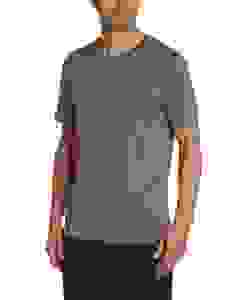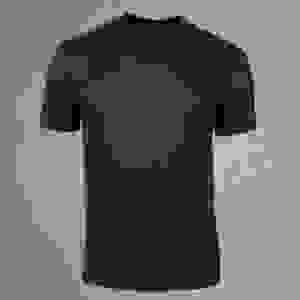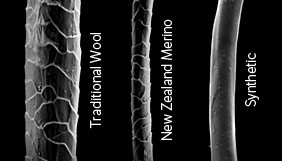There’s an interesting pattern that emerges from perusing the packing lists of long-term (or frequent) backpackers; they end up using eerily identical sorts of gear. You’ll see surprisingly consistent suggestions, such as using down jackets for warmth, traveling with just one pair of do-it-all shoes, using tiny airplane bottles, and so on. I call it the “objectivity funnel.” Despite the broad range of circumstances long-term backpackers run into, there’s an objectively correct answer (at least conceptually) to just about every situation. And one of the most consistently suggested items for travelers of all sorts is a merino wool t-shirt. Everyone will tell you to get one. Or two or three.

There’s a good reason for this. Cotton and polyester, which seemingly comprise 99% of the t-shirt world, have a number of irritating liabilities that simply won’t go away, which become especially problematic when subjected to the sorts of conditions that long-term backpackers often encounter.
- Cotton is incapable of drying quickly, meaning it’ll hold onto moisture all day long, so hand-washing clothes is nearly impossible. If you perspire heavily in the middle of winter, the moisture will stay all over you, sucking body heat away and slowly destroying your soul, a tragedy which I discovered the hard way in a below-freezing Italian winter with inadequate gear. I literally crawled under one of those hand dryers in a random bathroom to warm my chilled bones. Cotton is a problem in the heat as well; if you’re sweating heavily all day, particularly in humid weather, your t-shirt will become a sopping wet ordeal within a matter of hours.
- Polyester has a different sort of problem, as it dries quickly enough that it won’t accumulate horrific amounts of sweat, but it will accumulate horrific amounts of body odor. The smooth surface of the fiber is a spectacular breeding ground for bacteria, particularly when it’s hot and sweaty. Entire civilizations of microorganisms will rise and fall within the synthetic fibers of your snazzy polyester t-shirt, producing waste products that cause offensive and socially unacceptable smells. And it doesn’t matter if you’re using deodorant. That’ll make you smell fine, but not the fabric, where the colony will thrive. Polyester is also non-absorbent, meaning that when moisture has nowhere to go (if you’re sitting against a plastic chair, or carrying a pack), it’ll just sit there, feeling like a wet garbage bag. It’ll smell like one, too. Plenty of anti-odor treatments exist (it’ll say so in the product description if it has one) but they’re not always present, and occasionally ineffective.
Merino wool has none of these problems.
Why merino wool t-shirts work so well

As any long-term backpacker (whether traveler or mountaineer) will tell you, merino wool has something of a legendary reputation for comfort (mentally and physically), in a broad range of situations, from summer heat to winter chill, and outdoorsy adventures to lazy hostel lounging. It’s incredibly versatile, which is absolutely essential to shrinking a gigantic pack to practically nothing, particularly if you’re going to put it through the rigors of extreme temperature fluctuations and rivers of sweat flowing down your torso.
Merino wool pros:
- Merino wool is an excellent insulator, keeping you warm in the winter, and cool in the summer…within limits, of course, but much better than cheaply produced polyester t-shirts, which can often make you feel like you’re stuck in an oven.
- Merino wool is absorbent (unlike polyester, which just lets moisture sit stickily on the surface), but merino actually absorbs moisture to the interior of the fiber, whereas the surface pushes moisture away. This means it can actually be somewhat damp, yet still feel completely dry, which is a big part of the reason it’s so comfortable.
- It dries a lot faster than cotton; usually not as fast as polyester (though different fabrics vary), but fast enough that you can generally wash a merino wool t-shirt in the sink at night, and hang it up to dry by morning. Colder climates (and early risers) will make this more difficult, but only by a matter of hours. It also means you can go on a 12 hour hike and won’t be sopping wet by the end, because moisture won’t continuously accumulate like it does with cotton.
- It will never accumulate body odor. You will smell, but your clothing will not. The surface of the fiber provides a horrible environment for bacterial growth, so it just doesn’t survive. No bacteria, no smell. Mountaineers have literally worn the same outfit for several months at a time with no problems. If you’re wandering around in burning hot sunshine all day and then you have to walk into a hostel and hope to be socially acceptable, this is a huge deal.
- It otherwise looks and feels just like cotton, AKA it’s super soft and comfy, and doesn’t look techy. It can be a little out of place wearing polyester t-shirts all the time (particularly when the vast majority of those are about as shiny as the chrome plating on a brand new car, and have just as many ventilation panels, showy logos, and racing stripes), whereas merino just looks like a regular t-shirt (although I can tell the difference, because I’m obsessed with these things).
- Compared to other types of wool, merino has the additional benefit of not itching…at all. It’s a much finer fiber than “regular” wool (and often treated to soften the microscopically scaly surface of the fiber, which usually causes the itching), so if you’ve tried wool before and it drove you insane, it’s worth giving merino wool a try. You might legitimately be allergic to wool, but it might just be that you’ve been trying the wrong kind this whole time. I can’t wear a regular wool sweater for more than five minutes without going crazy, but I can wear merino forever.

These advantages come at a price, however. Pun intended.
Merino wool cons:
- They’re horrifyingly pricey…like, $70 for a t-shirt. It will very likely be your favorite t-shirt, and if you’re rotating through just a few items, you only need a few of them…but whether it’s worth the cost or not will depend on how seriously you make use of the advantages listed above.
- Bugs will eat them! Silverfish and moths will be your arch nemeses. People rarely run into these problems, particularly if the items are stuffed in a backpack, but it’s worth taking into consideration if you happen to see bugs like these. On the upside, merino wool is flame-resistant (whereas polyester burns immediately), so there’s a durability pro/con tradeoff here.
- They’re somewhat less durable than slick and smooth polyester. This is generally only a problem with really vigorous hand washing, which can eventually degrade the fabric, whereas with smooth polyester, you can scrub all day long as hard as you can, and nothing will happen. Thus if you’re hand washing merino wool, it’s a good idea to scrub a little more softly (and use more soap and water for extra cleaning power) so it’ll last longer. They don’t need to be washed that often anyway, but it’s still good to be gentle on a $70 item. Durability is comparable to high-quality cotton t-shirts, so this isn’t a “problem,” aside from the fact that you’ll want to maximize the lifespan more so than you would with anything else.
So! Are merino t-shirts worth the cost?

Many people will tell you that merino wool is so vastly superior in terms of comfort and versatility that there’s simply no reason to bother with anything else, and, if you aren’t in a financial mess, they’re correct. But I’m somewhat more price-sensitive than “just get them, they’re awesome,” because at $70 (or more) per t-shirt, it’s simply out of reach for a lot of people. Ironically, they’re especially out of reach for budget-stricken college-age backpackers on their way to sweltering summer climates where merino wool works amazingly well. Life is annoying that way.
So I’m going to describe the situations where merino wool works best, so you can decide if the cost/benefit analysis is worth it for you. The more you make use of merino wool’s spectacular features, the more it’ll become worthy of the investment.
You should probably invest in merino wool if:
- You need a minimum of clothing that handle whatever. Hot, cold, and everything in between, through long days of brisk walks through humid tropics, followed by sociable evenings that start too soon for you to take a shower. The more climate variations you’ll encounter, and the more you exert yourself throughout the day, the more sense it makes to use merino.
- If you sweat all day, every day, and have horrific problems with workout clothing smelling horrible after just a few hours of intense use, or cotton accumulating so much sweat that you feel like you’re wearing a wet sponge.
- You hate the sticky feeling of polyester, but still want something quick-drying, whether for comfort, or ease of hand washing.
- If you’re heading into snowy mountains, where you’ll be sweating ridiculously on steep uphill climbs, with windswept peaks with appallingly freezing wind chill, where moisture next to the skin will ruin your whole day.
As you may have guessed, merino wool is most useful at extreme temperatures (and trips that involve wild temperature fluctuations), and, if you’re traveling, I would argue that it’s more likely that this will be relevant in hot weather, as you’ll gain the advantages of moisture management and odor resistance, which are most important in sweaty conditions. It’s relevant in warm weather as well, since sweating lightly for 12 hours is going to create just as good a breeding ground for offensive bacteria as sweating heavily for 2 hours.

Merino also works nicely in cold weather, as it still manages to insulate, even when somewhat wet, and dries quickly enough that you can stay warm, which is critical if you’re sweating heavily in winter. I would say this is probably more important for hiking backpackers, and somewhat less important for travel backpackers, because travelers sometimes have a backpack which makes them sweat ridiculously (before they drop it off at the hostel), but hikers pretty much always do. Hikers also can’t duck into a coffee shop and sip a hot drink whenever they feel like it, or throw their stinky used clothing into a laundry machine, whereas travelers usually can.
You won’t need it if:
- You’re walking around in cool weather, you’re not sweating, and you have a warm-enough jacket anyway. If you’re wandering around town at a leisurely pace that doesn’t result in immense perspiration, merino wool’s moisture management and odor resistance are largely irrelevant. In cold weather it’s useful, since any perspiration might literally start freezing, but that only comes into play if you’re exerting yourself. In mild conditions at a slow pace, you can get by cheaply with ordinary clothing. Particularly if…
- You also have continuously available laundry facilities. If you plan on washing everything in a machine anyway, you’ll just take a shower whenever you feel the need to do so, and put on a brand new set of clothes afterwards. If you’re in mild weather and you weren’t even sweating much anyway, the performance advantages of merino wool will pretty much be invisible all day, and the quick-drying fabric will be mostly irrelevant if you’re also doing a machine wash.
I would actually argue that if you’re planning on a trip where the weather is going to hover between room temperature and slightly-cooler room temperature with a zero percent chance of rain, you don’t need performance clothing of any kind. It’s mostly in the crushingly brutal temperature extremes that high-tech clothing is most useful, and, when you’re traveling (or hiking), you often run into this a lot, and you don’t always have a home to hide inside of, so your only means of shelter is clothing. And it had damned better be good.

I’ve been through ridiculously blazingly hot summers, and brutally below-freezing winters, and got locked in a damn Italian train station overnight with inadequate gear in the middle of winter, where my stupid body decided to perspire all night long for no stupid reason, and since pretty much all I had was cotton, that sweat stayed there. Let me tell you, being wet and cold in the middle of winter while locked in a train station at 4am is the worst. Damn you, Italy. Damn you!
But that’s why merino wool is so beloved by scruffy backpackers all over the world. It’ll regulate your body temperature, pull excess moisture away from your body and let it evaporate, and it’ll look, feel, and smell great the whole time, no matter what sorts of nonsense you get yourself into. So no, it’s not that you “need” merino wool, but, if you find yourself ending up in these ridiculous situations over and over again, merino will make you feel a whole lot better than just about anything else.
Where can I get some?
Lots of people make merino wool t-shirts nowadays, so you’ll have plenty of options, from outdoorsy merino wool companies that specialize in the fiber, such as Icebreaker, Smartwool, Ibex, and Minus33, and outdoor/travel/performance companies such as Patagonia, Rohan, Outlier, and Wool & Prince, all of which have good options.
Aside from personal preferences on style and fit, the one thing you’ll want to look for is the fabric weight; 150 grams per square meter is a pretty standard, “normal” t-shirt weight, and good for a wide range of climates and situations. Some go down to 120 (which will be super light, but much more delicate), and up to 200 (which will be much stronger, but maybe too warm for the tropics).
Minor side note: Personally I prefer to wear nothing but t-shirts as a base layer (even when part of a winter packing list), because that way you can strip down to a t-shirt if you’re too warm, and leave the insulation to the other layers. Packing multiple t-shirts is also lighter than packing multiple thermal long underwear tops, and much easier to wash and hang dry as well. So regardless of where you’re going, I’d say just bring regular t-shirts, and add more layers when it’s cold.
Merino wool also makes great dress shirts, which not only do everything you see here, but are also completely immune to wrinkles! I’ve compiled a brief list here. Never iron anything ever again!
Is there anything comparable to merino t-shirts?
Yup! There’s magical miracle fabric out there that pretty much does everything merino wool does, and could probably be sold at half the price. It’s called Tencel, and nobody uses the damn thing. Argh!

Well, that’s not true. They use it for women’s clothing, because apparently only women enjoy feeling comfortable!?!? Argh again! But oh well. If you happen to have two X chromosomes, take a look at Nau, Royal Robbins, and Horny Toad, all of which have a billion Tencel options for ladies. It’s also called lyocell, so keep an eye out for that too. It drives me crazy how this is somehow a women’s fabric even though men sweat lots more. Argh!!!
I finally managed to find a couple things for men made out of the damn thing, and it shares a lot of the same properties as merino, but actually dries faster, which is why I keep blathering on and on about it. I’d love to see a t-shirt made out of this material, because I think it could be a great budget-friendly (and vegan) alternative to the tried-and-true merino wool t-shirt that everyone loves. Tencel is highly absorbent, quick drying, odor resistant, environmentally sustainable, and ridiculously soft. I can’t entirely determine at this point whether it’ll work just as well as merino (I literally cannot find a men’s t-shirt made purely of Tencel), but it feels great, and people should just start using it already.
What if I’m too poor?
If you simply can’t spend $70 on a t-shirt, have no fear. A decent budget alternative is simply to use a cotton/polyester blend t-shirt, which will give you the benefits of both fibers; it’ll be soft and absorbent, but quick-drying and shrink-resistant. It won’t be as good as merino, particularly when it comes to odor resistance (most cotton/polyester t-shirts are intended to be cheap, so they don’t bother with additional anti-odor treatments), but it’ll do.
I’m voting for Uniqlo’s Dry Packaged Crew, which is only $6 per t-shirt, and is pretty great. Not wear-it-three-days-in-a-row great, but maybe one or two, particularly in cool-to-warm (rather than cold-to-hot) weather. It’s made of seemingly higher-quality materials than anything I’ve seen at this price, and it’ll allow you to deal with sink washes and intense sweating fairly well, and for $6 each, you can spend the extra cash on other important things, like beer.
I would also add that if you’re traveling, it’s not a bad idea to bring one outfit you don’t mind ruining; a cheap polyester t-shirt makes a good “I’m going on a hike for 2 hours and showering afterward” layer, since you don’t have to worry about body odor in that case, and polyester t-shirts can be as cheap as $10, and if they get destroyed on a thorn-filled jungle trek, you won’t care.
Well, I hope you’ve enjoyed me going into ridiculous detail (I certainly did!), but I also hope this’ll help people make a better decision as to whether or not it’s worth dropping $300 on a few new t-shirts. Everyone will tell you they’re totally worth it, but I think it’s worth knowing exactly why. It’s a major investment, but a merino wool t-shirt is very likely going to be your new “I wish this were my only shirt” shirt.




I’ve been looking at picking up some merino tees but I’ve noticed something, a lot of brands have moved from 100% merino to nylon or tencel blends. Even Icebreakers Tech Lite tee is a blend now and I’ve read about some bad experiences with these shirts in Amazon reviews. Are there any brands besides Mission Workshop and Outlier that still make 100% merino tees?
I think Ibex and Smartwool have some.
I just wanted to pass this information along since this blog has been a huge help to me. If you’re looking to get some savings on merino wool clothing sites like icebreaker often have big sales during the summer and around national holidays. I’d recommend subscribing to their newsletter to keep updated.
Another good website for heavy 35-45% discounts is called steepandcheap. Icebreaker gear is regularly available there, although perhaps in different colors from whats on the website.
Finally for Outlier clothing check out a website called grailed. Grailed is like digital thrifting for high-end men’s fashion. Also if you check out the subreddit /r/outlier there is a monthly buy/sell/trade thread where you can find other deals on their products.
eBay always has some Outlier gear as well.
I found your site while browsing the web looking to overhaul my workout clothes. Turns out the properties found in “travel clothing” line up pretty closely with “gym clothing.” You want them to stay dry and odor free! I’m trying to find a t-shirt I can sweat through at the gym in the morning on my way to work and toss in my bag for the remainder of the day without soaking the rest of my stuff or stinking up the thing! Do you have any suggestions that won’t cost me an arm and a leg?
So the advantages of merino wool are that you can wear it during a workout, and then continue wearing it afterwards; this is especially useful for traveling, since you might not have the chance to change clothes and shower whenever you feel like it. However, if you’re planning on ditching the shirt in a gym bag, putting on a new shirt, and going to work, then you don’t need the anti-odor capabilities quite as much. You can go with just a regular, polyester workout shirt. I still like the ones with the anti-odor treatments, since you might as well smell nice, but you can get relatively cheap ones from regular fitness companies.
If you do want to try merino wool, a few direct-to-consumer companies sell directly through Amazon, such as Woolly, Woolx, Sheep Run, and others that you might find by random searching, and you can get an idea of what they feel like without having to spend on the higher-priced items. I don’t know if they’re comparable in quality, but it’ll be a relatively inexpensive way to test them out.
Thanks for the advice! If I’m looking for a shirt that will dry the fastest (to keep the things in my bag from getting wet) do you recommend a shirt that is 100% polyester or a blend like the Uniqlo crew you mention at the end?
Polyester will dry the fastest. However, putting a wet polyester t-shirt into a bag is usually a bad idea, because the odor will build up really quickly. The moisture has nowhere to go, so the bacteria just incubate inside, so you’d still want to let it air-dry all the way before packing. Stuffing a wet wool t-shirt into a bag is less of a problem. Not perfect, but better. A cotton/polyester t-shirt will dry slower than either one, and a pure cotton t-shirt would be even slower. I like some of the wool/polyester or wool/nylon blends, since they usually dry faster than pure merino, but keep the anti-odor performance seemingly just as well.
TL;DR Version: do you know if Tencel absorbs water like how cotton does — where your shirt gets all sweaty and sticks to you — or does it behave like wool in absorbing sweat while feeling dry?
——–
Hey, I found this article (and the discussions in the comments regarding merino vs. alpaca vs. Tencel) really helpful in researching fabric properties for performance T-shirts — it’s the best source on the internet that I could find for this topic, if that means anything to you.
Despite searching for several hours, I couldn’t seem to find anything about how Tencel “feels” on the skin. Because wool fibers are externally hydrophobic but internally hydrophilic, it can store a lot of water vapor — up to 30% it’s weight — inside the fibers themselves while still feeling dry and wicking effectively (for any sweat that does form on the skin rather than being absorbed in the wool as vapor).
Tencel is marketed as being very “absorbent” (e.g., “50% more absorbent than cotton!”), but I’m not sure how this is working precisely, and all the Lenzing literature seems perplexingly vague. My understanding currently is that the microstructure is composed of what they term “microfibrils”, which join together to form “fibers”: water is absorbed into the interstitial spaces (capillaries) between the microfibrils, hence “inside” the fibers. The lack of external water is what gives Tencel its odor resistance, like wool. (Bacteria need external water to multiply).
Since Tencel does not retain its insulation when wet, that would seem to imply that water fills (is absorbed by?) the air pockets in the fabric in a similar manner to cotton. But it is also claimed that it is “wicking” — a term generally used of hydrophobic synthetics like polyester that don’t absorb water but move it towards the fabric surface (cf. also the external behavior of wool fibers). These two things (absorbing to the point of insulation loss vs. wicking) seem contradictory, and I’m trying to understand how Tencel behaves when exposed to lots of sweat: like cotton, or like wool? Any hands-on-experience or capacity for (somewhat) scientific testing?
My hypothesis is that all of this confusion is related to the word “absorb”: absorbing water vapor INTO fibers would seem to be a good thing, while absorbing liquid (like cotton does) would seem to be a bad thing. Tencel’s value as a “summer replacement” for merino will depend, in my mind, on how much of its marketed “absorption” is the former rather than the latter.
Thanks
So I FINALLY got my hands on a 100% Tencel t-shirt, so I can offer actual advice, instead of speculation, and the answer is:
Merino feels drier next to the skin. I was initially looking forward to Tencel’s described property of absorbing water to the inside of the fiber, since that’s exactly what wool does; but what seems to be happening is that water is ALSO on the surface. Merino’s surface actually pushes water away, so the only thing the water can stick to is the inside, whereas with Tencel, it seems like water enjoys both the inside and the outside. So I think merino is still the gold standard. However, blending it with Tencel makes it wick and dry faster, and it’s less itchy, so I think there’s room for blended fabrics, which would combine the properties of both.
Thanks for the response!
Interesting that Tencel is somehow antimicrobial even with the surface water. I wonder how that works. Perhaps it’s more antimicrobial than plain old cotton due to better fiber-internal absorption, but less antimicrobial than wool? Do you have any experience with this aspect as well?
What exactly do you mean by “wick” in this context? Drawing liquid sweat away from the surface of the skin? (So “faster wicking” = “faster at moving sweat off your skin”)?
Finally, with regards to itchiness, it seems to me that Tencel blends would be unnecessary with Merino. Perhaps the blend might feel “smoother” (more silk-like) and drape better, but fine-micron Merino is already “not-itchy”, correct? Now Tencel-regular wool blends might be beneficial since Merino is so expensive, but that strikes me as a different matter.
I think Tencel absorbs faster, since the surface attracts water, whereas the surface of merino pushes it away, so Tencel pulls the moisture off your skin faster. And since it dries faster, that moisture will go away faster. However, I think it’s capable of retaining more water in total, since it seems to have higher absorbency, whereas merino has a lower limit to how much it can absorb, so it’ll never get sopping wet…or not for long, anyway. Especially if it’s a thin base layer.
And you’re right about the itchiness issue. Low-micron merino will be great, but it’s expensive, so merino/Tencel blends might be able to lower the product cost by allowing higher micron counts, but I wouldn’t go too high with it. But still…Tencel feels AMAZING. Softer than the softest merino t-shirt I have (though I’m not sure what the micron count of that one is). Shoving Tencel into merino is only going to make it feel wonderful, no matter the micron count. Also, Icebreaker says its merino/Tencel blends wick and dry faster, so it seems like a blend might be better than a pure fabric of either type.
I guess I think too much like an engineer, but aside from a certain base level of comfort (i.e., not being itchy or uncomfortable), “softness” plays almost no role in my choosing of clothing. Diminishing returns and all that.
My only hesitation with adding Tencel to merino would be that you’re trading wool advantages for things that may not matter as much. For example, for every bit of Tencel you add, the insulation value when wet will decrease, and the perceived moisture next to your skin will increase. And what do you get in return? Faster wicking (a definite positive)… but wool already wicks decently well. Unless you over-saturate wool (exceeding >30% weight by water), drying time doesn’t factor in to the comfort of the shirt (aside from the additional weight) since it will still feel like it’s dry.
I’d be interested to hear your thoughts on how Tencel compares to wool on odor resistance.
Some people are allergic to wool no matter how fine it is, and some people are vegan, so it was nice to think that Tencel could provide an alternative for those users as well. I also think you could, for example, blend Tencel into HIGH micron merino, which is more often used in sweaters; I have some Ibex pieces that are about 21 microns, and I can definitely tell the difference. If they had used 17 micron merino, it probably would have cost $400 or something (and the base price was $160 or so). But if they had blended with Tencel, it would have softened it up quite a bit, and it would have been cheaper, too. It wouldn’t have been quite as warm, but it would breathe a little more easily…although I think alpaca makes even more sense for sweaters, since it’s less itchy to begin with, even at high micron counts. There’s a company called Woopwear that uses an alpaca/Tencel blend, and I might give it a try.
I think the merino/Tencel blends could expand merino’s functionality at the warm end of the spectrum, rather than the cold; you lose insulation value, but if you’re walking around in Thailand in body-temperature heat, that’s probably exactly what you want. Wool seems to get progressively more itchy the more you sweat, too. At least in my experience.
Icebreaker’s Cool-Lite fabric uses a blend of 65% merino, 20% Tencel, and 15% nylon, and they say it’s their most breathable layer. It’s also lighter than their regular t-shirts (135 g/sq m instead of 150), but I think the Tencel is part of the functionality, drawing water off the skin and drying faster than pure merino. So it seems like it doesn’t take a huge amount of Tencel to acquire this added bonus, and it works better in the heat, and as long as the Tencel content is relatively low, it’ll still feel mostly like merino in terms of next-to-skin dryness, insulation, and so on.
It’s a little hard to give a definitive answer, since there are so many different types of Tencel, and it’s practically impossible to find anything made out of it anyway. I actually have a couple Nau t-shirts that are about half merino and half Tencel, but I think the fabric is a bit thicker, so it feels warm, which is the opposite of what I’d want, but they certainly manage moisture nicely. The Element Pure base layer is also a little thicker than a lightweight t-shirt, so it feels a bit warm, too. So I still think merino is best, but maybe a little Tencel makes it nicer in the heat.
H Steven & Snarky,
Mike from Element Pure here, we made some Tencel Baselayers last year (95% Tencel A100 + 5% Elastane). I’d like to add my input to the discussion here.
Regarding whether liquid is absorbed inside the fiber or not the short answer is yes. Steven your understanding is quite correct. Structurally, Tencel is made from millions of nano-fibrils, which creates a massive amount of surface area and nano-pores within each fiber. This causes sweat to move from the surface of your skin to inside the nano-pores via capillary action and ultimately to the other side of the fabric and evaporated away due to natural evapotranspiration. Due this structure, Tencel fabric’s water holding capacity is much higher than cotton/PES (polyester)/wool. This also means the RATE of evaporation will also be much higher than cotton/PES/wool.
Now whether Tencel fabric ends up feeling wetter or not against your skin vs merino wool really depends on how much you sweat.
If you are like my girlfriend who doesn’t sweat much, then the advantage goes to Tencel. Because you’ll feel dry all the time with a fabric many times softer and smoother against your skin than the finest merino wool.
If you sweat alot, let’s say more than the holding capacity of the Tencel fabric. Then of course some water will remain on the surface of the fabric! Actually think about any fabric. If we pour a bucket of water on it, no matter how absorbent or how quickly it evaporates, they’ll be some water on the surface of the fabric/fiber simply because it’s in a supersaturated state.
Hope that clears some things up. Let me know if you guys have any more questions. You can check out what we have at elementpure.com
Cheers,
Mike
Thanks for the details. I can tell what’s going on in terms of what it feels like, but can’t see what’s happening on a microscopic level. And it sounds like you’re probably right in terms of heavy sweaters vs light sweaters; I tend to sweat a lot, so even with mild exercise, it seems like I was overloading the absorption capacity.
Tnecel is mainly antibacterial due to the fact bacteria are too big to access the water in the nanopores.
Once again, if you keep Tencel fabric (or any other fabric for that matter, even merino wool or silver fabric) in a supersaturated state, then they will all end up smelling bad.
You going to tell us where/what?!
Oops, sorry about that. It’s from Element Pure. I’ll be doing a proper review at some point. I still think merino is the gold standard, but Tencel is a good option for those allergic to wool, or vegans. It has good moisture management properties, but you don’t want to get it too soaked, as it’s capable of absorbing huge amounts of water. It can dry fast, but its max absorption is so high that it’ll take a while to dry if you get caught in the rain, for example. It also doesn’t have quite as dry of a next-to-skin feel, but it’s as good as I’ve found for non-merino fabrics. A Tencel/polyester blend would be great, too.
I got one of their longsleeve crewneck shirts a few days ago, and so far I love the feel of the fabric. Haven’t had a chance to test wicking/drying, but the fit is pretty odd … seems cut more like a women’s shirt. The neck opening is very large, the sleeves are loose, and the waist is really snug. Don’t get me wrong, I buy slim-fitting shirts, but this is something else…
Yeah, it’s much more like a base layer fit. You can go a size up, but then the sleeves are a little oddly shaped, although in the short-sleeve version it’s not a big deal.
Hi Stefan & Snarky,
Thanks for supporting us! We appreciate your feedback. We are working hard to finish our Version 2 (V2) baselayers based on feedback from Kickstarter backers and customers like yourself. And we hope to be sending those out for a full review.
The new design and cut should eliminate a lot of the issues like the ones you and Snarky identified here. We are also adding the 3 most requested colors (grey, blue, and white) in addition to our current black.
Once again thanks for your support!
Cheers,
Mike from Element Pure
Unfortunately I found the perfect travel t-shirt…
I have worn it for everything for years, and I sweat more than anyone i know, despite usually being in fairly decent shape.
Still this particular t-shirt handles it in most situations, it has a rare ability to not actually get visibly wet from perspiration unless its really really heavy perspiration, which i really like, despite it being light grey. I have worn it on long walks in mountains and I prefer it to most of my synthetic shirts for performance (the synthetics include som HellyHansen ones and a Uniqlo Airism)
So that’s all amazing and great, right?
Well… It was made by a fashion brand…
They clearly didn’t do it on purpose, and they offer absolutely nothing even remotely similar today.
-in fact i wrote the company behind the brand (Bestseller) and included every single piece of information in the washing label to make them help me find something similar, but they pointed me towards a 100% cotton t with a Kiss (the band) motif…
Clearly that’s not very helpful…
It’s a Jack&Jones Originals with a Sex Pistols motif, it was bought in 2013 and it is heather grey.
More importantly though it is 70% polyester and 30% cotton, despite looking and feeling more like a more silky, less wrinkly cotton T than anything synthetic.
I have naturally bought dusins of different polycotton blends chasing this level of performane, but to no avail.
Uniqlo’s packaged dry suck in comparison (dry much slower and get visibly wet at the instant you start perspiring, even in darker colours) and ive tried a few different plain tshirts (usually sold for printing) with 65% polyester and 35% cotton but clearly its not about the material composition, but rather about the weave or yarn of something… Those ones have very low breathability (meaning you will perspire more when wearing them, also overheat much easier) and they feel nowhere near as nice..
My t-shirt still has some good years left in it, so at least i’ll still have one perfect travel t-shirt for a while longer, it just sucks that I apparently can’t ever get more, despite the fact that i know they have been manifactured…
-probably there is a factory in Turkey that still produce that fabric in that quality, but I have no idea how to figure out what t-shirts it might end up in…
Yeah, there are different grades of cotton, and different grades of polyester, so it’s hard finding a winner if all you know is that it’s a blend. Very annoying. But I’m glad you found something you’re happy with.
Hello,
I am trying out merino wool t-shirts in hopes to find a shirt that I can wear multiple days before needing a wash, but unfortunately, so far, the 18.9 microns are too itchy, so hopefully the 17.5 or 16.5 microns will do the trick.
In the meantime, I have wanted to try the Patagonia (or any brand) with the Polygeine permanent odor control t-shirts and baselayers.
Problem is, I have recently tried the Patagonia boxers with the Polygeine, and the odor control is not working even after just one day of use, and was wondering if you had any experiences with these types of shirts, baselayers, etc with odor control additions.
From my experience, these odor control garments seem to be ineffective in the underarms areas, etc where bacteria can thrive more.
Just wanted to get your thoughts/and or experiences.
Thanks,
Ian
I’ve heard that if you use a lot of deodorant, the bacteria can actually build up on the deodorant itself. It seems pretty weird, but that’s what people say. Using a lighter amount or a natural deodorant seems to help. Anti-odor fabric treatments can only go so far, so I don’t know if there’s a perfect option out there. Silver seems to work amazingly well, but Patagonia wanted something non-metallic, for environmental reasons. I actually don’t know of too many other synthetic options (though I got a test sample shirt from Yathletics that works quite well in that regard), because I’ve mostly switched to merino. It looks so much nicer and more natural than most synthetics, and I feel weird when I’m wearing shiny polyester in bright colors, and merino is just great.
Hi,
Is a 100% merino wool t-shirt better than one with 78% merino and 22% nylon. Also how effective is it in a hot tropical region like the asian subcontinent.
So I’m pretty sure you’re talking about the Wool & Prince t-shirt, which is great. I got a test sample, and the anti-odor performance seems to work just as well as regular merino, and I’m glad it has the extra durability of nylon to make it last longer. I’m quite happy with it (although I’m a little tall, and it could be an inch or two longer, although he said some early samples were coming out a bit shorter than they were supposed to). It seems just as comfortable and functional as regular merino, and I’ve tried other merino/synthetic blends that didn’t work, but with this one, I couldn’t tell the difference. It’s lovely.
It hot and humid weather, nothing is going to feel “good,” but I prefer the natural feel of merino instead of the plastic feel of polyester, especially if you’re sitting in a plastic chair with no breathability, or you’re wearing a backpack and your back gets coated with sweat. Merino absorbs, feels mostly dry even if it’s a little damp, and dries out pretty quickly. It feels more comfortable to me pretty much all the time. It’s not going to feel “comfortable” when you’re drenched with sweat, but it’s going to be better than anything else I’ve tried. Linen button-up shirts are great, but they get so wrinkly that I don’t like using them.
Thanks, how would you compare it with the Unbound merino t-shirt. Am looking to travel to Europe later this year and looking to build up my wardrobe, have got a Rohan Fusions, thinking of going in for a Bluffworks Pants, W&P button down and couple of tees, either W&P or Unbound. What would you recommend having personally tried both of them. Also any other button downs or tees I should look into?
The W&P t-shirt looks just a tiny bit more normal, because it uses regular seams instead of flat seams. Not a big deal, but flat seams look a little bit more like athletic gear. Unbound is also much looser. I think it’s about one full size bigger than the W&P. Some people like that, of course, and if you’re tall and skinny, it might be useful, since the W&P is shorter. Otherwise they’re both going to work just fine. A couple other ones that look like regular t-shirts are from Triple Aught Design and Outlier, and they both have great reputations. Outlier has some button-downs too (along with Ninox, Libertad Apparel, Smartwool, Icebreaker, and Ibex), though I haven’t tried all of them. W&P has the biggest selection by far, as they specialize in doing just those things.
there is a company called unbound which makes 100% merino wool t-shirts and claims you can wear it for 46 days continuous. what are your thoughts on the same.
He sent me a sample shirt, and it’s working quite nicely. It’s pretty big, so if you want a relaxed fit, get your regular size; if you want a slim fit, go a size down, or you can use a dryer to dry it (but then it won’t last as long as a shirt that’s air-dried). It’s a solid choice.
Also would you advise going in for a travel jeans (Aviator) or a Bluffworks Pants. Know both are different types but just wanted to understand from an overall point of view (drying time, comfort, stretch, anti-wrinkle, stain resistance) as these would be one of the only two pairs I would be taking for the trip besides Rohan fusions.
A lot of people out there like taking one pair of purely synthetic pants and one pair of semi-synthetic pants. It makes for a good combo. On hikes, you can bring the synthetic one, and when you’re lounging around town, jeans feel great. The synthetic ones will obviously dry faster, but if you’re using the jeans just around town, they’re not going to get dirty all that quickly, so it’s no big deal. It’s hard to make the call, so I would just recommend picking whichever one you think you’ll enjoy wearing more, which is partly just a fashion preference. There’s just something about jeans…
A tip for the frugal–and it’s only for cool to cold weather activities. Check out merino wool sweaters from thrift shops. I have 4 or 5 100% merino light-medium weight sweaters that I have bought for $3-4 each. I bought them for cycling in cool and cold weather where I didn’t want to freeze from sweaty cotton or stink from synthetic cycling jerseys. I picked up this tip from a cycling forum and was a bit skeptical of merino’s hype about odor control. But, I’ve been won over. I can wear the sweaters 4 or 5 times and still do not have odor. Immediately after a ride, it may have slight wet wool odor but once dry, it’s odor-free again. I actually just wash the sweaters after awhile as I figure they must be dirty…even though they don’t smell.
I stick with 100% merino as I’ve read that blending with the synthetics may lead to odor. It’s interesting to read about the new blends–maybe they have figured out a good mix. I’m on the hunt for clothes that I can cycle in for the summer. I used to be a spandex roadie and didn’t care too much about odor control (go ride, come home, get out of the gear and shower). But now that I cycle primarily as a means of transportation, I need civilian clothes that I can bike in. It’s particularly difficult to find lightweight long sleeve summer shirts/blouses that also can stand up to sweat and odor. I want long sleeve for sun protection. Last summer, I used very lightweight long sleeve cotton shirts and just pretended the sweat patches/stains weren’t that noticeable…
I agree with a post above–really dislike the merino shirts for women that are super tight and clingy.
I just love the idea of a hardcore biker cycling around in a fancy cashmere sweater. Those quarter-zips are pretty much the same as a fancy mountaineering base layer anyway, but made of wool. You’ll look amazing all damn day.
Long-sleeve merino t-shirts tend to work pretty well for what you’re describing. Several companies nowadays make merino wool button-up shirts, but as far as I’m aware, they’re just available for men at the moment. See if you can find something with Tencel, which is more often available for women. It’ll be breathable and wrinkle-resistant, though more suited to warm weather than cold.
Lol, hardly hardcore anymore now I have hung up the spandex. I stick with a basic look but yeah, for a few dollar bills I am riding around town in Ralph Lauren, J Crew, Made in Italy, etc sweaters!
My hangup with long sleeve merino t-shirts is that they all have that base layer look–tight and clingy. It gets over 90 degrees and 90% humidity here in the summer, I don’t want the shirt to be that fitted.
Yeah, that’s true, and a light sweater is basically a long-sleeved t-shirt anyway, though maybe a little thicker. Long-sleeve polos might not have the base layer look, and they’d have some adjustability with the buttons and neck protection for the collar when you’re in the sun, or in the wind.
Tencel / merino blend t-shirts and all linen t-shirts at https://seagale.fr
Also other garments made in the tencel / merino blend.
No, I haven’t tried them…
Yeah, I’ve seen those, although they’re all the way over in France, so I haven’t given them a try either. Hopefully some of my French readers will see it, though.
Well, I thought with you being a nomad and all…
Perhaps, more realistically, a British reader might see it – no duties, easy postage etc etc. I’ve got some of their other gear and it’s all pretty good stuff if their fit, er, fits you.
More of a Bedouin at the moment, but I’ll try to make my way over there now that I’ve learned some French. I was in Paris when I was maybe 7 years old, but that’s pretty much never.
Thanks for the link, it’s nice to see more normal looking performance clothing from stores in europe. Getting stuff from places out of the eu gets really expensive for me after import duty and vat get added.